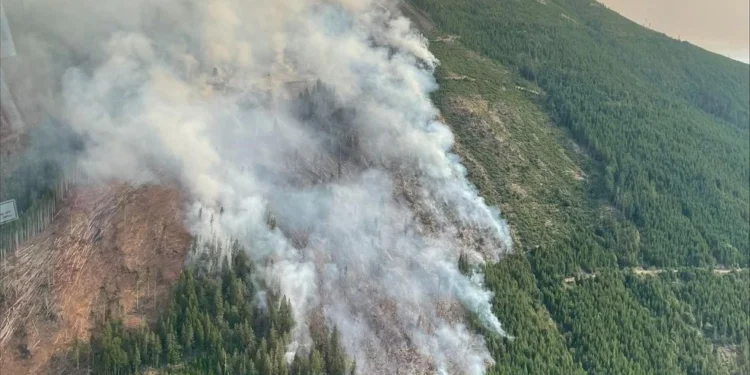Wildfires across Washington state have consumed more than a quarter-million acres this year, according to the Washington Department of Natural Resources.
Public land officials and firefighting personnel are expressing concerns about potential future hazards due to funding reductions in wildfire prevention and forest health programs.
“There are 1,851 fires that started in the state and it burned 251,840 acres this year,” said Dave Upthegrove, Washington Public Lands Commissioner, with approximately 40% of these fires affecting western Washington.
He noted, “The Bear Gulch fire was the largest fire in western Washington that we’ve seen in a generation.”
In Mason County, the Bear Gulch, Toonerville, Hamma, and Browns Creek fires caused substantial damage.
“Drift smoke reduced air quality to dangerous levels throughout the region. Homes were threatened and people were evacuated,” said Casey Whitehouse of Central Mason County Fire & EMS.
Firefighters credit House Bill 1168 for improved wildfire preparedness.
The legislation, approved in 2021 by the state legislature, allocated $500 million over eight years to the DNR for wildfire preparedness and response, with $115 million provided in the last two-year budget.
“In Mason County, the fire service has used House Bill 1168 funding to upgrade and purchase new equipment that has made us safer and more effective when we were dispatched to a wildfire,” Whitehouse explained.
However, facing a budget deficit, lawmakers have reduced wildfire prevention funding.
“The funding we have for wildfire prevention response was cut in half. If that funding isn’t restored, we’re going to see more fires, bigger fires, and more cost to taxpayers, more risk to property, to life, more damage to our environment,” Upthegrove warned.
Firefighters are urging lawmakers to restore the funds. Whitehouse expressed hope, saying, “I hope we can continue these House Bill 1168 funded programs into the future because we know they work.”
The 251,840 acres burned across 1,851 fires represents an average fire size of 136 acres, though this statistic masks dramatic variation between small grass fires extinguished quickly and massive conflagrations like Bear Gulch that consumed thousands of acres.
The 40% western Washington fire concentration challenges traditional perceptions of wildfire as primarily an eastern Washington problem, with climate change increasing drought conditions and fire risk in historically wet regions west of the Cascade Mountains.
Dave Upthegrove’s characterization of Bear Gulch as the largest western Washington fire “in a generation” suggests the blaze exceeded anything experienced since the 1990s or early 2000s, marking a concerning escalation in fire behavior west of the Cascades.
The Mason County fire cluster including Bear Gulch, Toonerville, Hamma, and Browns Creek indicates concentrated fire activity in a single county, potentially stemming from weather patterns, fuel conditions, or ignition sources creating multiple simultaneous incidents.
Casey Whitehouse’s description of drift smoke reducing air quality to “dangerous levels throughout the region” references particulate matter concentrations exceeding EPA health standards, forcing vulnerable populations indoors and creating respiratory health emergencies across multiple counties.
The home threats and evacuations demonstrate wildfire impacts extending beyond burned acreage to include psychological trauma for displaced families, economic losses from business closures, and emergency response costs for shelters and traffic control.
House Bill 1168’s $500 million allocation over eight years represents roughly $62.5 million annually for wildfire preparedness and response, a substantial investment reflecting legislative recognition that prevention costs less than suppression and rebuilding after catastrophic fires.
The $115 million provided in the last two-year budget translates to approximately $57.5 million annually, slightly below the eight-year average, suggesting funding front-loaded in early years or back-loaded in later budget cycles depending on legislative priorities.
The equipment upgrades and purchases enabled by House Bill 1168 funding likely include fire engines, protective gear, communication systems, and hand tools that modernize rural fire departments previously relying on aging equipment inadequate for contemporary wildfire challenges.
The “safer and more effective” characterization indicates new equipment reduces firefighter injury and death risks while improving suppression capabilities through better pumps, hoses, thermal imaging, and protective clothing that allows closer approaches to flames.
The budget deficit driving wildfire prevention funding cuts reflects Washington’s revenue challenges where economic downturns, tax structure limitations, and competing spending priorities force legislators to reduce programs despite demonstrated effectiveness.
The 50% funding reduction represents dramatic retrenchment from wildfire prevention investments, potentially eliminating forest thinning projects, prescribed burns, fire break construction, and public education campaigns that reduce ignition risks and fuel loads.
Upthegrove’s warning that funding cuts will produce “more fires, bigger fires, and more cost to taxpayers” articulates the false economy where prevention spending reductions generate larger suppression costs, property losses, and environmental damage exceeding the budget savings.
The “more risk to property, to life, more damage to our environment” framing encompasses residential and commercial structures threatened by flames, firefighter and civilian casualties, and ecosystem destruction that takes decades to recover from severe burns.
The firefighter plea for lawmakers to restore funding creates political pressure during budget negotiations where compelling testimony from frontline responders carries weight with legislators facing constituent demands for fire protection.
Whitehouse’s hope to “continue these House Bill 1168 funded programs into the future because we know they work” references measurable outcomes like faster response times, improved containment rates, and reduced acreage burned that demonstrate return on investment.
The western Washington fire increase correlates with climate change models predicting warmer temperatures, reduced summer precipitation, and longer fire seasons that transform historically fire-resistant forests into fire-prone landscapes requiring aggressive prevention.
Seattle-area residents experienced degraded air quality from distant wildfires this year, with smoke from eastern Washington and British Columbia fires drifting westward to blanket the metropolitan area in hazardous particulate matter requiring indoor air filtration.
The Mason County fires threatened Hood Canal communities and timberlands supporting Washington’s forest products industry, with potential timber losses affecting local mill employment and tax revenues from commercial forest harvests.
The budget debate over wildfire prevention funding reflects larger tensions in Washington politics where progressive legislators prioritize social services and education while rural representatives emphasize natural resource management and public safety in forested counties.







